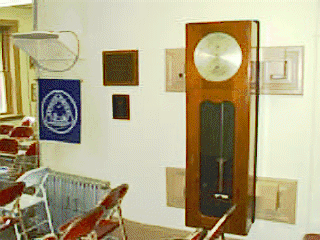

10. Another of the wall mounted Chronometers on the main floor. Note that it is affixed thru the lathe and plaster wall and into the central pier (see later images).
MORE HISTORY: In the summer of 1926, as his health continued to fail, Herbert Howe began instructing Albert Recht, a faculty member from the Math Department, on how to operate the telescope. Recht had joined the University of Denver in 1923. Prior to coming to the University, Recht had been a high school principal and Spanish teacher in Wray, Colorado. He had honed his Spanish by spending six months in Nicaragua as a surveyor, mine sampler and shift boss at a gold refining mill.
As Recht pointed out, it was serendipity more than design that saw him inherit the directorship of the Observatory. His first step into astronomy was quite accidental. While teaching high school in Wray, he gave his students the choice of studying agriculture or astronomy. "It was a rural area, of course, so I just assumed they would decide on agriculture," he later recalled, "They didn't. Why, I'll never know... I kept just ahead of the students all the way."
Recht applied to DU to teach Spanish, but landed a job in the Math Department. Still interested in astronomy, he introduced himself to Herbert Howe, and began learning the ropes at Chamberlin. He was named acting Director of the Observatory in 1926 and full Director two years later. In conjunction with his new duties, Recht worked over the span of eleven consecutive summers to get his Ph.D. in Astronomy from the University of Chicago, where he worked at the Yerkes Observatory. His thesis was on comet d'Arrest, for which he received his doctorate in 1939. Although Recht continued his analysis of cometary orbits, and did some work in lunar occulations with professor Thomas Bartlett, his top priority at Chamberlin became the popularization of astronomy.
He began the tradition of public nights and during his tenure a quarter of a million people looked through the twenty-inch refractor. So popular were public nights that by the 1950's, reservations were required up to three weeks in advance to look through the telescope. The Rocky Mountain News noted: "It's the greatest show in Denver, playing currently to packed houses, admission free, reservations booked for weeks ahead."
Home, Previous image, Next image.